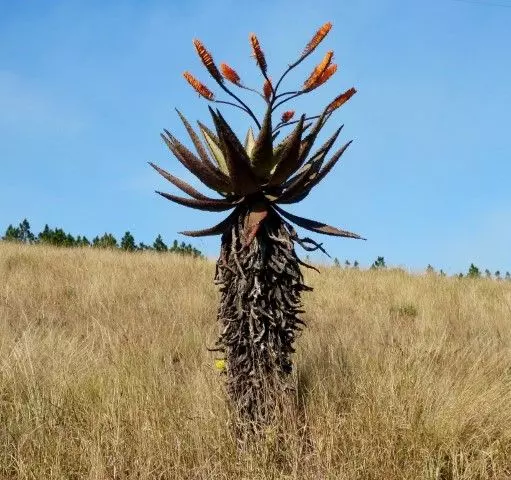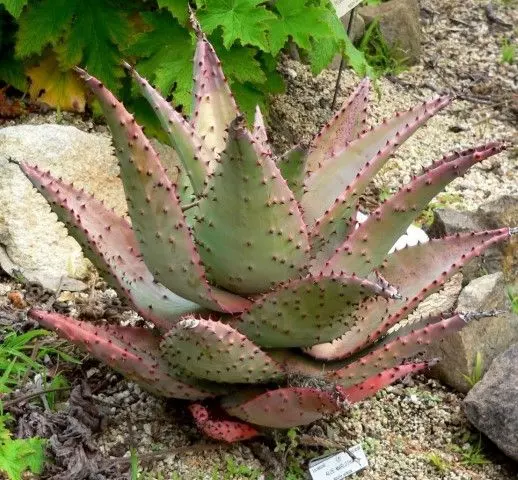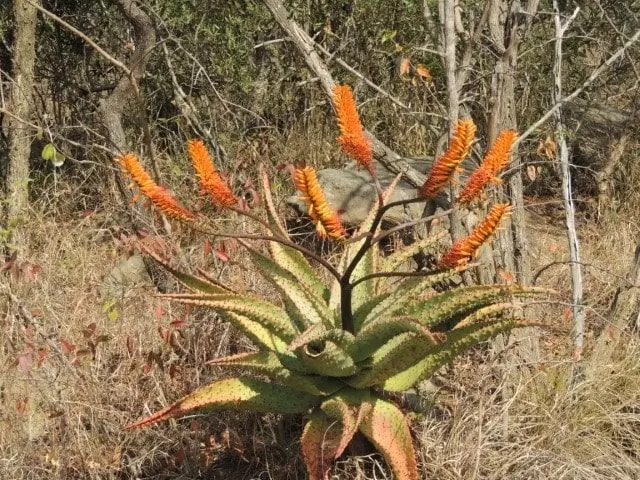Aloe marlothii or Mountain Aloe is a large succulent with a generally unbranched stem. This beautiful plant is topped by a rosette of gray-green to bluish-green leaves with a sharp tip and reddish-brown spines along the margins and randomly on both surfaces. In this article, I summarize tips for Aloe marlothii care. Also, I give you the step-by-step guide for Aloe marlothii propagation.
The leaves are up to 5 ft (1.5 m) long and 10” (25 cm) wide and the stem grows up to 10 ft (3 m) tall, usually covered by the old, withered leaves.
As it ages, it loses many of the spines on the surface of its leaves.
The specific epithet “marlothii” honors the South African botanist Rudolf Marloth (1855-1931), so it is also known as Marloth’s Aloe.
Aloe marlothii is a native plant of Botswana, Malawi, Mozambique, and South Africa.
Table of Contents
Aloe marlothii Characteristics
Aloe marlothii Characteristics. Let’s take a look briefly to their characteristics
- Aloe marlothii enjoy the indirect sun.
- Aloe marlothii is resistant to cold up to 19.4°F (-7ºC).
- Aloe marlothii grow up to 10 ft (3m) high and 10 ft (3m) wide (diameter), although slow growth.
- Aloe marlothii is not suitable for outdoor cultivation in non-arid areas.
- Aloe marlothii is propagated by cuttings.
- The ideal temperature for growing Aloe marlothii is between 77°F and 95°F (25 ºC and 35 ºC).
- Aloe marlothii requires less watering than other Aloe species.
- Aloe marlothii is not toxic for humans or pets.
Aloe marlothii Care
Aloe marlothii Care – Lighting
Aloe marlothii Care. When growing aloes such as Aloe marlothii indoors, place your plants near a south- or southwest-facing window that receives plenty of bright, indirect light.
Provide light shade, especially during the hottest part of the day.
Aloe marlothii Care – Fertilization
Another tip for Aloe marlothii Care. Aloes generally do not require fertilizer but can benefit from extra nutrients. Consider these fertilizers as the food the plant needs. Aloe marlothii is a slow-growing aloe. These types of slow-growing aloes will remain several years on the same substrate so that a little bit of nourishment can make a difference.
You can apply a little succulent fertilizer at least once a year in early spring. The other option is to replace some of the soil with new soil. This will replenish and renew the nutrients that have been lost.

Aloe marlothii Care – Watering
Aloe marlothii Care – Watering. This aloe needs regular watering but is very tolerant of drought conditions for short periods. As I have said on many occasions, water deeply, but only when the soil is completely dry.
Reduce watering during the winter months.
Aloe marlothii Care – Location: Where to Plant Aloe marlothii
Aloe marlothii Care – Location: Where to Plant Aloe marlothii. Aloe marlothii should be placed in a well-drained soil specially formulated for cacti and other succulents or prepare your mix with large particles.
Drainage is essential because too much moisture around the roots can cause root rot.
Aloe marlothii is not particularly fast-growing, so it should be repotted every two years or so. I always recommend doing this when the roots cover the current pot.

Aloe marlothii Propagation
Aloe marlothii Propagation. Three ways to propagate Aloe marlothii.
Seedlings and Seeds Aloe marlothii
Aloe marlothii Propagation. This aloe can be propagation by using the tillers, cuttings, or seeds from a mature plant. Being a very prolific plant we will have a wide range of opportunities to propagate it.
Aloe marlothii Propagation by Leaf Cuttings
Aloe marlothii Propagation by Leaf Cuttings. The leaf cuttings are always taken from the lower leaves, trying to take them from the base.
- At the point of the crack, the Aloe marlothii jelly comes out. We must wait until this point of incision is completely closed. If we do not do it this way, it would end up rotting.
- Once the base is closed and dry, we put the leaves in a substrate as permeable as possible.
- Use one with a little volcanic gravel, sand and a little peat. In this way, we are putting the cuttings in so that they root and new plants come out.
Aloe marlothii Propagation by Steam Cuttings
Aloe marlothii Propagation by Steam Cuttings. Another way to propagate Aloe marlothii is to take cuttings from stems.
We make an incision in them and let the cut dry completely, developing a kind of crust at the base.
How long does it take for an aloe cutting to dry before planting? How long does it take for an Aloe marlothii cutting to dry before planting? It is advisable to wait about 1 or 2 weeks in summer, in a shady and well ventilated place.
Then we put them in the lightest possible soil so that the roots can start to develop and the Aloe marlothii cuttings can thrive.
Aloe marlothii Propagation from Seeds
Propagating Aloe marlothii by seeds. The last and most time-consuming way of propagating Aloe marlothii is to obtain seeds and sow them.
We do not recommend propagating Aloe marlothii from seeds as it is too slow a propagation method for a type of aloe that grows so little per year.
How to propagate Aloe marlothii from seed. Aloe marlothii develops cone-shaped flowers. From these flowers, a kind of pods come out and, inside them, there are seeds.
By tapping the flowers, small black seeds come out. Harvest them on a surface of silica sand and maintaining the humidity, small seedlings of Aloe marlothii will come out little by little.
Learn more about general guidelines for succulent propagation
Is Aloe marlothii Toxic to Pets?
Is Aloe marlothii Toxic to Pets? Like other species and varieties of aloe vera, this species may be toxic to cats, dogs and horses, due to its saponin content, causing vomiting in small pets and even lethargy.
Aloe marlothii Flowering
Aloe marlothii Flowering. Flowers are orange to bright red and appear in late fall and winter in a widely spreading branched panicle with up to 30 clusters.

